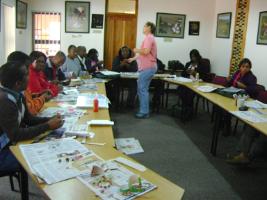
As the second week RU/SADC ESD Leadership alumni course 2012 ends, the class had a fantastic time with Michelle Craig, who came to ELRC from WESSA to facilitate a workshop in which waste cardboards were used to make earrings , necklaces and bracelets. In a space of 15 minutes on the minimal, participants were engaged in the activity/demonstration as Michelle unrolled the interesting hands on activity in paper crafts. She works for WESSA in the department of Education and finance and whenever an opportunity avails itself, she said “I get my self involved in learning more crafts skills in order to share more ... and I also do embroidery, chokers, crocheting and knitting, skills which I learnt when I was five.
The participants, who for most of the time were bombarded with theoretical complexities by different scholars, were now given hands on activity where they were made to think complex but act simple to enhance learning. Among the processes involved were the random pickings of cardboard, cutting it in a triangular shape, gluing and then rolling it. The first steps usually were filled with nervousness became evident too was that it was an interesting activity. Most ,if not all were taken aback to the years in their childhood days at pre schools, primary school days when paper crafts made them be part of the childhood play.
As the activity went on, there was a lot of discovery as the participants tried to come up with different shapes and designs, but one thing so interesting was the discovery on how to match colours. Without studying the colour wheel and its theories, it was possible to use colour in an intuitive manner, thus positively contributing to a thought that every one is born with artistic tendencies and responses.
One would ask; what lessons were learnt out of this activity? Perhaps the response from many a participant was that it was fun to play with paper in a creative manner. But to one whose interest goes beyond the simple activity, he or she would see the power of creativeness that contributes to the reduction of waste, especially paper. It also contributes to be a learning activity where manipulation and aesthetic skills are taught, thus promoting the power of learning by doing. Furthermore, such activities have an empowering effect in as far as sustainability commons are concerned. This indeed is a way of livelihood to communities like the ‘iPhepha Beads’, who make and sell these products both to local and international clients, whose courtesy needs to be acknowledged.
Finally, it can be stated that the activity ended on a note where other participants were so enthusiastic that they carried some beads and cardboard to go and keep on experimenting and according to their individual taste of colour, beads and cardboard. Of course, many stated that they would give their beloved ones the necklaces, bracelets as presents without really stating that these were made of paper especially from the waste bins. Written by Crispin Cholwe and Adesuwa Vanessa Agbedahin.
